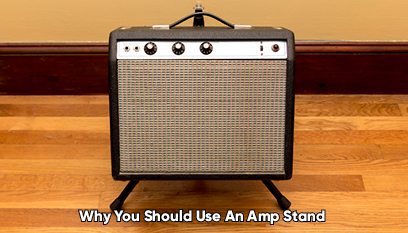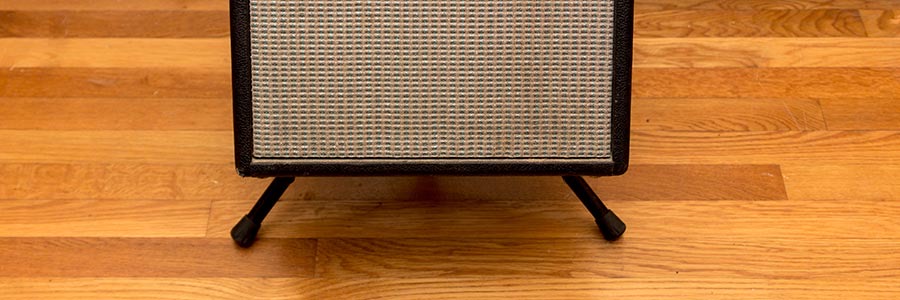
You’ve undoubtedly been to shows where the guitar player had their amp on a milk crate or a chair. Maybe that guitarist was you! In this post I’m going to make the case for investing a few bucks in an actual amp stand instead.
Why do you need an amp stand? For starters, you don’t hear through your legs. An amp stand aims the sound at your ears, so you can hear what you’re playing. It also gets the amp off the floor, which helps reduce stage volume and makes life a little easier for your front-of-house engineer (if you’re lucky enough to have one). The audience will get a better mix at a reasonable volume, and that means a better experience for your fans.
A Stand Directs the Sound Where It Belongs
The primary purpose of an amp stand is to direct the sound where you want it to go, which will vary depending on the situation in which you’re playing.
Let’s say you’re playing a gig with a limited PA system. It can amplify the vocals, but not much else. It that case, your amp has to not only project your sound to the audience but also get it to your ears so you can hear what you’re doing.
If you’re playing a gig where the amps are mic’d, you’re not necessarily out of the woods. There may not be enough monitors to go around, or the system may not be able to handle individual monitor mixes. You’re going to be happy that you can use your amp stand to help self-monitor.
Even if you’re in the sweet spot where the house PA is robust enough to take care of all your needs, the available stage space can be limited. Some amp stands allow you to fasten the cab mic to the amp stand, which saves precious real estate on small stages.
An amp stand also helps ensure that the sound you hear is closer to what it actually sounds like to the audience. Without one, you may end up adjusting your settings until the music sounds good to you with the amp pointed at your ankles or your calves — but the audience gets blasted with treble.
A Stand Gets Your Amp Off the Floor
When your combo amp or your cab sits directly on the floor, some of the vibration goes right through the floorboards. That means noise is traveling around the building, and you will likely have to turn up the volume more than you otherwise would to make up for it. If you’re trying to practice quietly because you live in a condo or apartment complex, playing with your amp on the floor could very well lead to noise complaints from your neighbors. Decoupling the amp from the floor is pretty important.
Some players leave their guitar amps on the floor because they like the way the low end sounds. But it’s important to recognize that the extra boominess and bass response from an amp lying directly on, say, a hollow plywood stage is not part of the tone coming out of the amp. You’re not losing bass tone by putting the amp on a stand — you’re just not adding it. If you’re playing through a PA system, that extra bass tone is just for your benefit anyway. The audience won’t be able to hear it. Different materials interact with sound differently, so having your amp on a stand lets you standardize your settings a little bit. When you play on different stages, you won’t have to do quite as much adjusting. Do you usually practice in the basement? Concrete doesn’t vibrate very much, so you may not notice a whole lot of sound benefit from using an amp stand in your lower-level lair. But if there’s ever any water in your basement, you’ll be really glad your amp is off the floor in a stand! I’d also strongly recommend a dehumidifier to keep your guitars happy, if your basement is prone to moisture like mine.
So What are the Best Amp Stands?
It all depends on what your needs are as a player. Personally, my favorite amp stand, and the one that my Vox AC15 is sitting on at this very moment is the On-Stand RS7000, which you can find on Amazon here.
I like the RS7000 because of the way it holds my amp (in a leaning back “L” shape) makes me feel like the amp is fully supported and in no danger of falling over if someone bumps into it. I also like that it has three different height settings allowing for versatility in different settings.
My other amp stand is the Ultimate Support AMP-150 which can also be found on Amazon. This stand bills itself as ultra compact (true) with three angle positions (also true).
What the headline doesn’t mention is that the top of the Y-axis support is threaded to a microphone boom can be added for micing the cab when space is at a premium and not having to put up another stand is a major space saver.
I like both, and I don’t think you can go wrong with either, but the difference maker in my opinion is that the higher profile of the RS7000 makes it easier to get right up on it for controlled feedback – which I’ll get into more later in this article.
Why Not Put Your Amp on Chairs or Milk Crates?
You can try elevating the amp with other things, like milk crates, chairs, or even hockey pucks.
Chairs are a particularly poor choice. If the gig is crowded — and we certainly hope it is! — you are taking a chair that a fan might want to use. Don’t inconvenience the audience because you’re too cheap to buy a proper stand for your amp. Depending on the kind of amp you have and the design of the chair, the chair could actually block the vents and trap heat around your amp. You definitely don’t want that!
Some people argue that milk crates pull double duty, because you can use them to cart around cables and other gear you need for the show. But a milk crate with an amp sitting on top of it is a terrible place to store anything that you might need to grab in the middle of a gig! And besides, milk crates just look shoddy, like the show was thrown together at the last minute. Like decent band photography, a real amp stand is a signal that you take your band seriously.
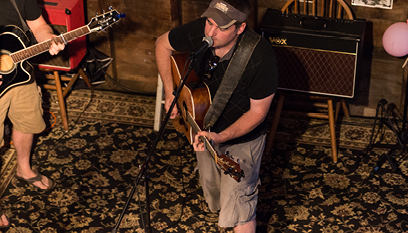
If you’re going to raise a heavy amp off the ground you obviously don’t want it falling over, and relying on milk crates and random chairs can be risky. A road case is sturdy enough, but you may not have one of those. An amp stand has another advantage over objects like chairs and milk crates: it tilts back. Amp stands tilt so you can aim the sound where you want it to go. Tilting the amp at an angle makes your amp less useful as a place to rest beverages, but it’s hard to see less beer being spilled on your gear as a drawback.
Tilt-Only Options
Some manufacturers make wedges or very low amp stands that don’t elevate the amp much at all — their sole purpose is to tilt the amp back. A similar option is adding tilt-back legs to your amp. (This usually requires screwing into your amp, but some designs basically use very strong Velcro instead.) Some amps, especially older Fenders, are actually designed with built-in tilt-back legs that you can choose to use or not.
You can try these tilt-only methods to see if they provide enough benefit for your situation. For example, if you have enough room on stage to stand 10 feet in front of your amp, just tilting the amp back may work fine. But if you have to stand closer than that, it’s probably better to elevate the amp as well to make sure the appropriate sound reaches your ears.
Other Suggestions for Reducing Stage Volume
Amp stands are a great way to reduce stage volume so your audience doesn’t get blown away (in a bad way!). If you’re already using amp stands and you’re still being told your band is too loud, consider some other solutions:
- Stand right in front of the monitor if you can. This is called being “on axis,” and it helps ensure that you’re hearing the music the way you’re actually playing it.
- Try in-ear monitors instead of floor monitors. (Check out my post about hearing protection for more information.)
- Practice playing at a lower volume at rehearsals. Don’t wait until you get complaints at gigs to figure this out.
- Play with experienced musicians. To be blunt, a drummer who only knows how to play at ear-splitting volume is not a very good drummer.
Another possible solution is to switch to modeling amps or electronic drums, but I’m guessing anyone reading a post about amp stands wants to keep using real amps and real drums.
A Stand Puts the Amp at a Convenient Height and Keeps It Stationary
Most amps are heavy and awkward to carry. It’s safer to lift an amp from a stand than from the floor, because you don’t have to bend over as much. (Not that you should be lifting with your back to begin with!) It’s also easier to reach the controls mid-gig when they are elevated, although you may find them more annoying to reach if the amp is also tilted back. You can experiment and see what works best for you. Since many amps are fitted with casters on the bottom, an amp stand is useful for keeping the amp still so it doesn’t roll around.
Lastly, an amp stand puts the amp out of range of people’s feet, so your amp is less likely to get kicked by people trying to maneuver around a small stage. Why deal with a torn grill cloth (or worse damage) if you can avoid it?
A Stand Makes It Easier to Get Controlled Feedback
Ever seen a guitar player take the guitar off (often at the end of a song or the end of the whole set) and wave it in front of the speaker to intentionally create feedback? That kind of feedback is much easier to create when your amp is elevated, because the guitar and the amp have to be at a similar height. You could crawl around on the stage to get this effect, I suppose — but it wouldn’t look very rock ‘n roll.
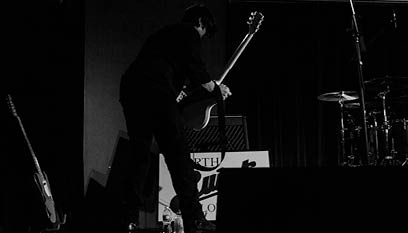
Do You Need an Amp Stand for Bass Cabs?
Most bass players keep their amps on the floor. For one thing, bass amps are usually larger and heavier than combo amps for guitars. They’re also usually taller than guitar amps, so the upper speaker (if there is one) will be closer to your ears. In addition, bass wavelengths are less directional than higher frequencies are, especially at the bottom end. That makes pointing the amp in a particular direction less important.
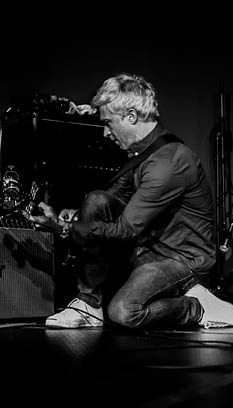
What About Vocals?
It’s important to keep your vocal mic away from your guitar amp to reduce feedback. When you set up your amp stand, make sure it doesn’t point the sound directly at a vocal mic. That can be tricky if you sing as well as play guitar, but it can be done. You may wonder if it’s possible to plug a vocal mic directly into a guitar amp. You can plug a vocal mic into a guitar amp, especially if the mic has a pre-amp… but it’s a lot easier to control with a PA system.
Definitely don’t use any of the amp’s distortion options with vocals unless you like the sound of screeching!
Features to Look For in Amp Stands
Hopefully I’ve convinced you of the benefits of amp stands. When you start looking at amp stands, you’ll notice that they come with a variety of features. How much these particular factors matter to you depends on how you plan to use your amp stand. For example, you might not care about your amp stand folding up easily if it’s going to stay at your practice space most of the time. But foldability will be a much bigger issue if all your gear has to fit in the back of a hatchback! Here are a few things you may want in your amp stand:
- Rugged design (metal construction, not plastic)
- High weight limit
- Lightweight
- Adjustable tilt
- Adjustable height
- Folds into a compact unit
- Integrated microphone stand
The Bottom Line
Amp stands are a great idea for a number of reasons, but they’re pretty much essential for playing live. And hey, once you upgrade to an amp stand, you can put that milk crate to a better use — like storing old knickknacks that you have every intention of dropping off at Goodwill one of these days.

